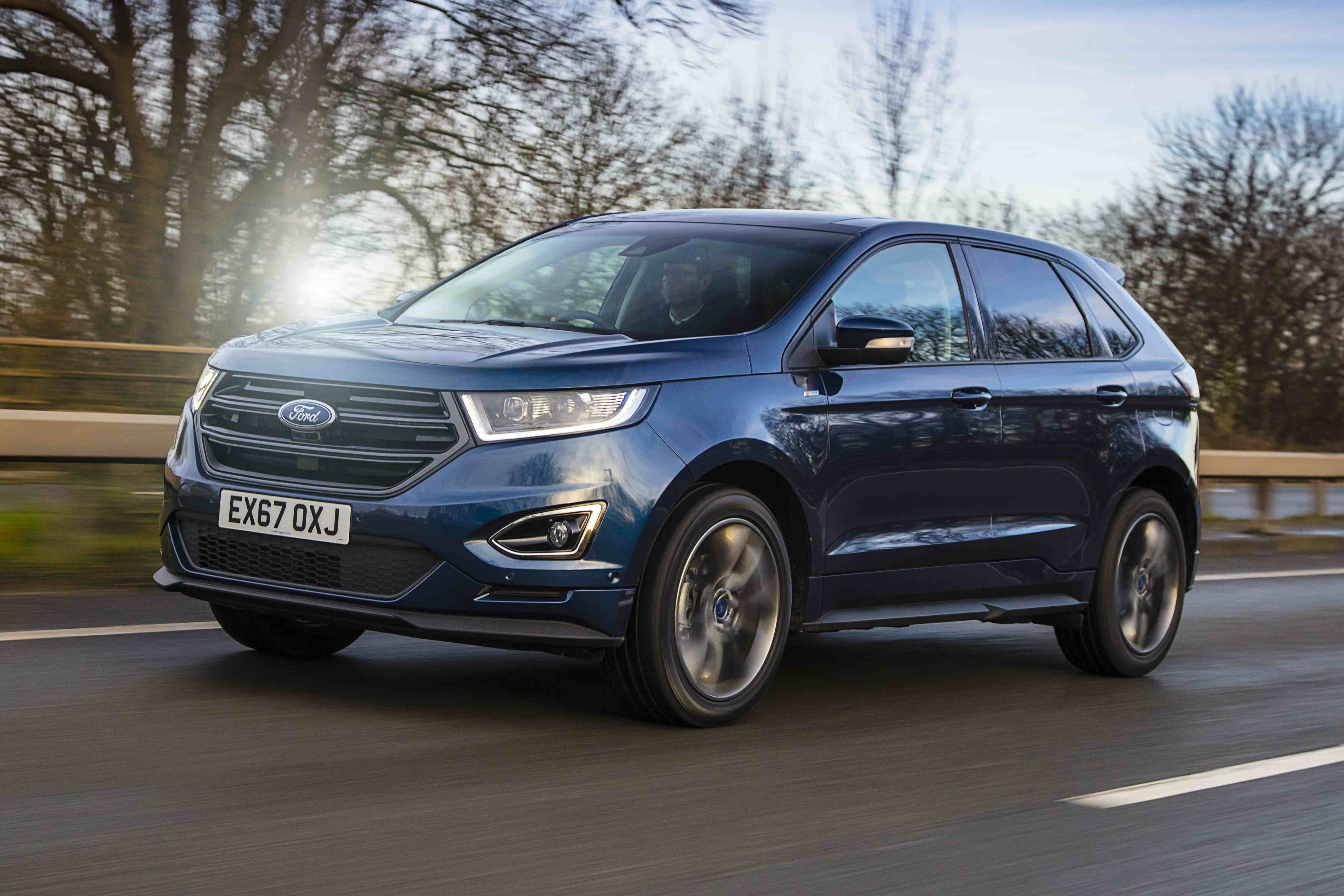Ford Edge (2016-2019) Review
Written by Andrew Brady
Quick overview
Pros
- Enormous boot
- Great motorway cruiser
- Loaded with equipment
Cons
- Not as fun to drive as other Fords
- Limited engine range
- No seven-seat option
Verdict: Is the Ford Edge a good car?
"Ford lacked an offering in the big SUV sector and therefore took one from its US range, giving it an easy way in. Safe to say that some of the prejudices you might have about American cars ring true here, as the Ford Edge was big, spacious inside, not particularly subtle nor tremendously excited about corners either. As a used buy however it has some potential."

The Ford Edge is a North American SUV that was once refined to European tastes; think of it as a gastropub cheeseburger, gussied up with a brioche bun and aioli dressing, but still an indulgent, fatty and simple meal.
When it first reached the UK in 2016, Ford was faced with the dilemma of where to slot it in a market that already had lots of options for buyers looking for a big, five-seat family car with a raised up driving position.
Bravely, they decided to stuff the Ford Edge with standard equipment and price it just under premium rivals such as the Audi Q5, BMW X3, and Mercedes GLC, offering more toys than those cars and a spacious interior.
Unfortunately, in reaching for the stars, this car made itself much harder to justify than other SUVs. It looked expensive compared to the Skoda Kodiaq and Mazda CX-5 - yet it couldn't match cabin quality. The posher Vignale versions competed with cars that were nicer to drive.
Originally, it came with four-wheel drive only, and either 180PS and a six-speed manual gearbox, or 210PS and an automatic transmission from a 2.0-litre diesel. The line-up was changed in 2018, and a new engine was introduced that was more economical, coming with 150PS and front-wheel drive, or 238PS as a 4x4.
Both of the newer versions got a relaxed eight-speed automatic gearbox, and the engine was refined, with plenty of low-down pulling power, but leisurely performance due to the Edge's size and two-tonne weight.
It felt slower than most premium SUVs, and despite only using diesel power, it wasn't very economical either.
The rest of the driving experience was similarly disappointing. As you'd expect of a car designed to work in vast flat states like Iowa and Minnesota, it was a hushed, steady cruiser with slack controls and soft suspension. Yet the ride was also too firm, pattering across broken surfaces at low speed and thumping stiffly over potholes.
It also paid a big penalty for its size. You'll have trouble squeezing into parking spots designed with Pumas in mind and will be holding your breath to avoid scraping the bumpers on width restrictors and car park barriers.
While this exterior bulk did give the Ford Edge plenty of road presence and made it comfortable inside for five adults, many rivals offered seven seats, which gave them MPV flexibility. These cars could also swallow more luggage than the Ford, without the same feeling of driving a tank through small village lanes.
In too many areas, the Ford Edge was merely average, while in others, it was too compromised to recommend in favour of its wide array of talented alternatives. Excellent standard equipment and safety features didn't make up for its low-rent interior and so-so driving dynamics, and its premium aspirations didn't stack up for UK buyers.
Looking for a used car for sale? We've got 100s of Ford Approved Used Cars for Sale for you to choose from, including a wide range of Ford Edge cars for sale. If you're looking for the different model, you can check out our Ford Kuga review.
Is the Ford Edge right for you?
The four-wheel drive version had healthy outputs of 238PS and 500Nm. Combined with its porky kurb weight, the Ford made an excellent tow-car, but it wasn't as fast as those figures suggested.
This was a comfortable, spacious cruiser, with decent refinement that could take long journeys in its stride, and its interior - while lacking the wow factor of premium competition - had every possible gadget.
It also scored highly for its impressive rear passenger space and enormous boot. Still, most SUVs that were in this price range (and plenty below) offered seven-seat options, giving family buyers greater flexibility.
Many of its rivals were also available with petrol-electric hybrid powertrains to help save fuel and cut their CO2 emissions, but the Ford Edge made do with diesel power alone, something that was likely to put some buyers off.
What's the best Ford Edge model/engine to choose?
We'd suggest opting for a used 180PS or 238PS car in standard trim. The 150PS is too sluggish and will frustrate if the car's used daily. The former has enough kick with decent running costs, while the latter offers a bit more oomph with higher running costs.
What other cars are similar to the Ford Edge?
The Ford Edge faced tough competition from every corner of the SUV market. If you had more to spend, the excellent Audi Q5 and BMW X3 felt much nicer inside and had refined road manners to match.
If you wanted the versatility of seven seats, the Land Rover Discovery Sport was priced close to the Titanium trim, competed well in the spec count, and had a more upmarket image - plus an even bigger boot capacity.
Seven-seat buyers with less to spend were well served by the Peugeot 5008 or Skoda Kodiaq, which both come with a wider variety of engines and cost less to run and insure than the bigger, heavier Ford Edge.
Arguably, the latest Ford Kuga and Toyota Rav4 are modern equivalents.
Comfort and design: Ford Edge interior
"We only had good things to say about the Ford Edge's driving position. The standard seats were wide, comfortable and very supportive, with 10-way electric adjustment making it a doddle to situate yourself behind the pedals."
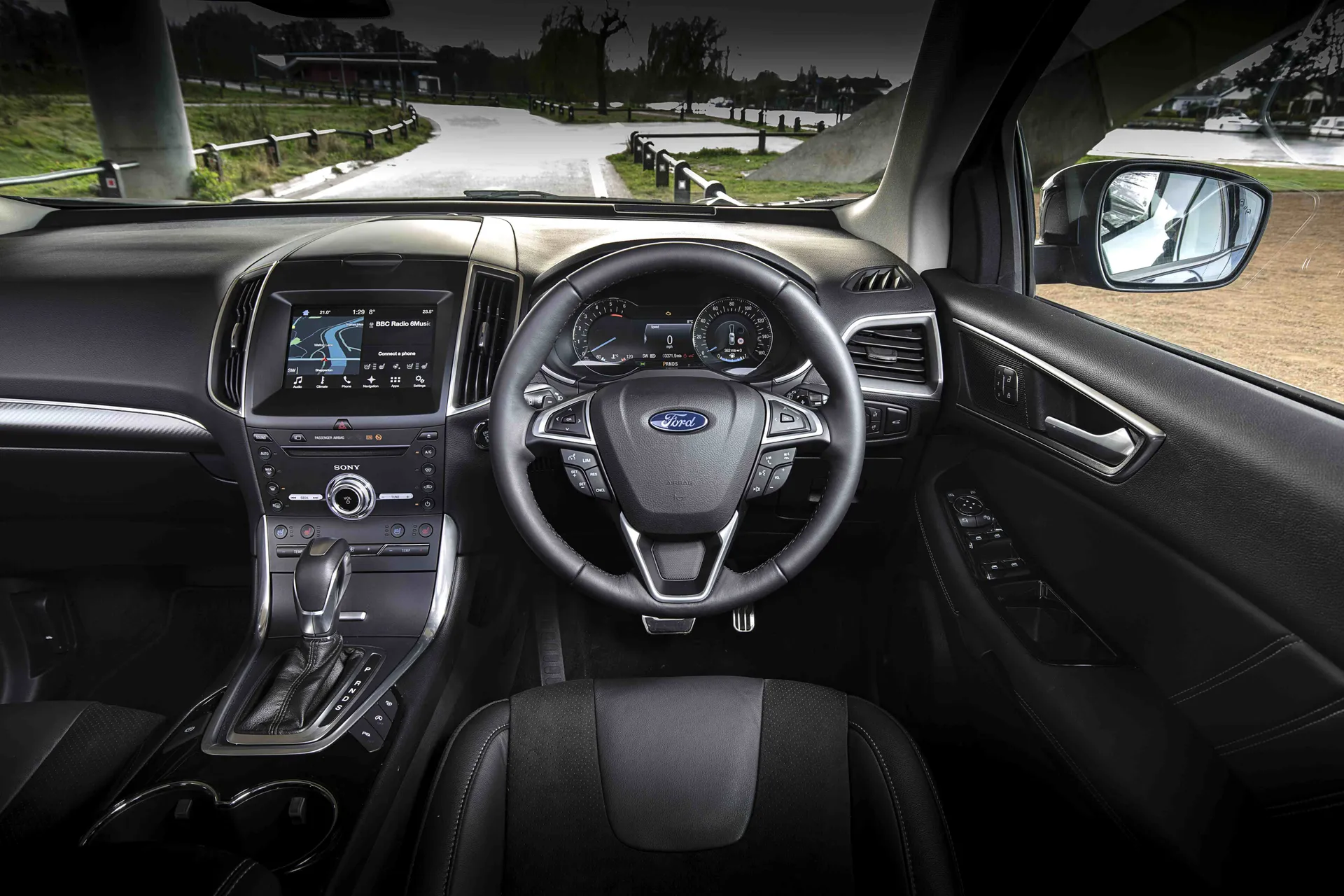
The steering wheel offered plenty of scope to meet taller or shorter drivers at the perfect arm-length, and both front seats had four-way lumbar support. You could spend hours driving this car without a hint of backache.
On cold winter mornings, everyone in the car could have a toasty bum; front and rear seat heating was standard, even on the Titanium trim. It also had ventilated front seats.
You sat high enough to have a good view out over other traffic, although a Land Rover Discovery Sport gave an even more commanding stance. Visibility wasn't great, though, with large blind spots from the thick pillars, meaning you craned your neck at tight junctions - it was also tricky to judge where its bluff bonnet ended.
The centre console was placed within easy reach, but the small buttons were hard to read, making it challenging to hit them the first time when moving. The design was drab, but after its facelift, Ford introduced a rotary gear selector to declutter the cabin, in turn making accessing the climate controls less challenging.
Quality and finish
For a model meant to be taking on cars with some seriously prestigious badges, the Ford Edge felt dated.
There was stitched leather in the door panels and covering the dash, but the design was workmanlike. There was a lot of hard plastic in the centre console, cheap-looking silver trim inserts, and small, easy-to-miss buttons.
Things you'd touch often, like the steering wheel and gear selector, felt okay (without being the special items you might want at this price), but flimsy air vents and heat controls were an instant reminder you were in a Ford.
It had the lavish equipment of its upmarket competitors but just couldn't compete on interior style or execution.
That might sound harsh, but when cheaper rivals like the Mazda CX-5 and Peugeot 5008 looked smarter and felt more special - let alone the premium competition - we thought it was only right to demand better.
Flagship Vignale versions gave a superficial nod in the direction of luxury, with softer leather trim, quilted seats with extra padding, and illuminated door sills, plus more cow hide around the instrument binnacle. It wasn't enough to disguise the cheaper materials lower down in the cabin, though.
Infotainment: Touchscreen, USB, sat-nav and stereo in the Ford Edge
Every Ford Edge had an 8.0-inch colour touchscreen in the centre of the dash. Pre-facelift models got the 'SYNC 2' version of Ford's infotainment software, but later cars had the significantly smarter SYNC 3.
That was backed up by a 12.3-inch set of digital instruments, controlled using the numerous identical-looking steering wheel buttons. It had too many menus, though, and wasn't as easy to read as Audi's Virtual Cockpit.
It was hard to fault the number of features, with Apple CarPlay and Android Auto smartphone mirroring, sat-nav, DAB radio, Bluetooth, voice control, and a reversing camera all standard, but it wasn't as advanced as rivals.
The main issue was the touchscreen itself. You could pinch and zoom, but the response to your attempts to prod the small on-screen icons was hit-and-miss. It often worked the first time, but others needed three or four tries.
Since the layout was clunky and the sat-nav confusing, we advised on ditching the Ford system in favour of a phone for navigation, calls and media playback. The interface was more intuitive and instantly familiar.
ST-Line and Vignale versions featured a premium B&O stereo with punchy sound from its 12-speaker setup, but the touchscreen interface was the same and was just not as modern or slick as Audi's MMI or BMW's iDrive.
Space and practicality: Ford Edge boot space
The Ford Edge was almost as big as a Range Rover, and its hulking dimensions translated to a lot of interior space. It only had five seats, but the decision not to squeeze in a third row meant it was absolutely palatial in the back.
It was so wide that you could fit three abreast without anyone feeling uncomfortable - something that was rare even for an SUV - because the seats were really wide, and there was only a small hump in the footwell to negotiate.
The rear seats reclined to help increase passenger comfort on longer trips, and you could fit two child seats in the outer spots and save room for an adult in the middle - a godsend if you had a fussy toddler on board.
Some models had inflatable rear seat belts to better protect kids in the event of a crash by spreading the impact load over a larger area. Unfortunately, these belts didn't reel like a normal seatbelt and weren't compatible with some child seats, so be sure to test them carefully before you buy one.
The boot - like most other things about the Ford Edge - was huge and had some clever functionality built-in. It opened electrically either with a press on the key fob or by waving your foot under a sensor in the bumper.
Inside, the 602-litre loading bay was wide and square, there was virtually no load lip or useful lashing points to stop awkward items rolling about. Under the floor were two extra hidden storage boxes and switches for dropping the rear seat backs (handy when you're carrying something heavy) to open up a 1,788-litre space.
It was impressive and was, in practice, more than enough for most family clobber, but seven-seat rivals the Skoda Kodiaq, Discovery Sport or Peugeot 5008 could all carry a fair bit more.
They also gave the flexibility of carrying more passengers and not just luggage in a pinch. The third row was usually pretty cramped, but it was nice to have the option, especially if you had a larger family.
Handling and ride quality: What is the Ford Edge like to drive?
"Including the mirrors, it's over two metres wide, which forces you to regularly mount the verge on narrow country lanes to let others pass, and hold your breath in multi-storeys."
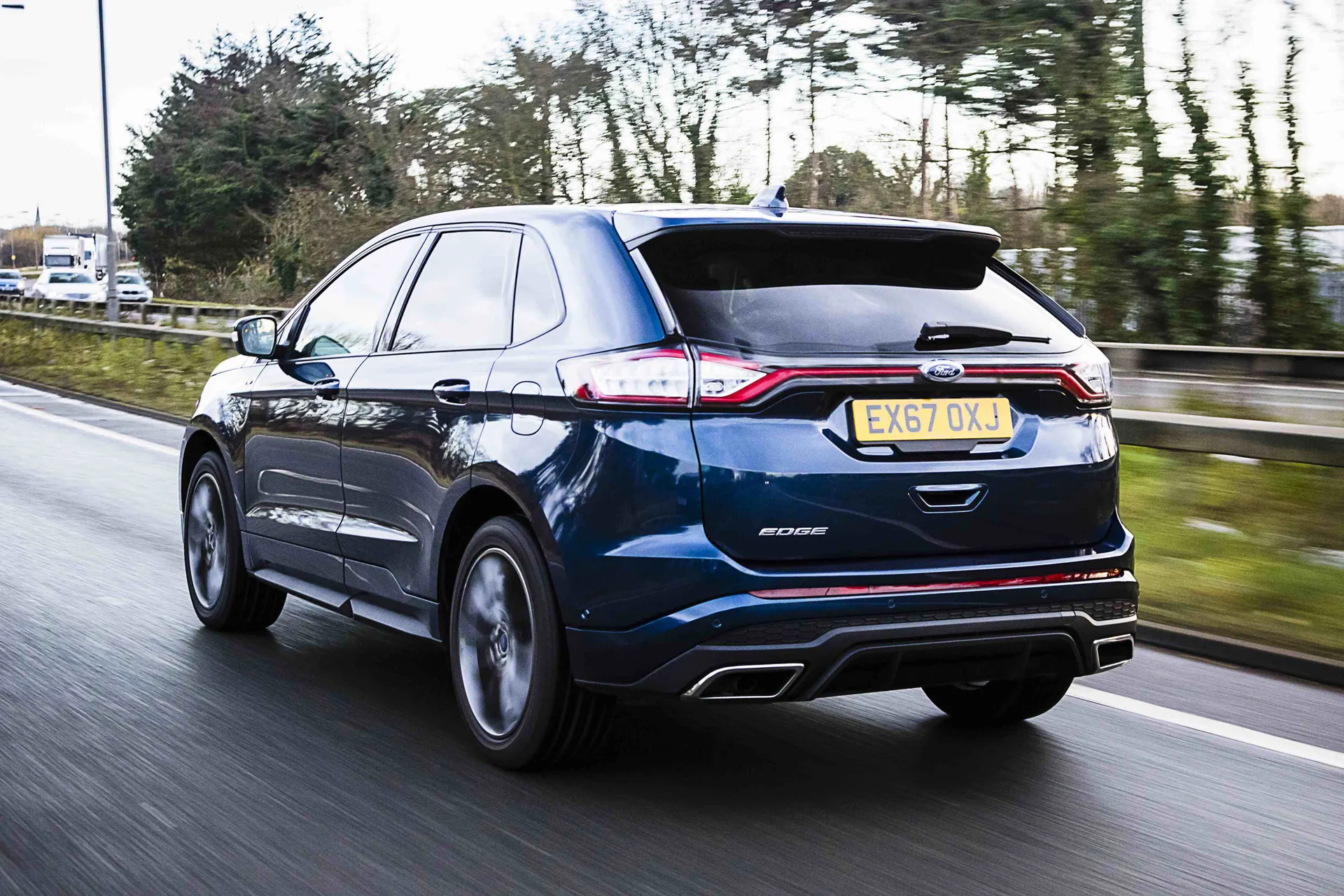
It felt cumbersome, a sensation enhanced by the vague steering, which lacked the accuracy needed to place the car confidently. The huge body leaned in corners too, lacking composure.
We could've forgiven the Ford Edge if it was a paragon of comfort, but the ride was actually rather firm. The ST-Line was worse with its sporty suspension.
It thumped and crashed over the worst imperfections, while its larger wheels made the ride borderline uncomfortable at most speeds. The entry-level Titanium was plusher but still made you fully aware of lumps and bumps as you passed over them.
The Ford Edge hung on gamely enough, the tyres gripped effectively even in the front-wheel drive model, but the slow steering and ponderous way it changed direction would soon put you off any ideas of driving fast. The dull controls meant it was well suited to long, dead-straight roads, but outside the motorway, it struggled.
Now, plenty of same-era SUVs felt similarly compromised, but most were planted and stable, providing a more comfortable low-speed ride, and didn't feel as unwieldy on British roads.
What engines and gearboxes are available in the Ford Edge?
One thing Ford didn't provide much was choice. Most rival SUVS offered at least one petrol alternative, and in many cases, greener alternatives like hybrid, mild-hybrid or plug-in hybrid tech to save fuel.
The Edge featured the same 2.0-litre diesel from the Mondeo, and that was it. There were two different outputs: front or four-wheel drive, but both had a conventional eight-speed automatic 'box.
This fitted well with the more powerful 238PS engine and was far superior to the six-speed auto found in the pre-facelift car, but it was still not the sharpest transmission. There was a delay of several seconds between pushing the throttle and the car reacting, so you had to learn to anticipate its dim-witted reactions when pulling out of junctions.
It had decent low-down grunt - great for towing - and was quiet and smooth, but despite a high output, the performance was best described as leisurely. Most of its premium rivals felt a lot quicker with similar power.
The lesser 150PS engine was even more sluggish; it simply couldn't counteract the car's sizeable bulk. But it will also save you a little in daily running costs, but don't expect it to deliver significantly better fuel economy.
In either spec, this is simply not a car for buyers looking for a high-riding SUV with a sporting bent. Driving it harder in the search for excitement will reap no reward and spoils refinement, so it's better to meet the Edge on its own terms, sit back and relax.
Refinement and noise levels
The Ford Edge was first and foremost a big, comfortable motorway cruiser and its hushed cabin played into those strengths. It had a secret weapon to isolate its passengers from the outside world, too: Active Noise Control.
This worked the same way as posh noise-cancelling headphones, using microphones to listen out for unwanted disturbances and playing white noise to counteract them through the in-built speakers. It worked well - engine clatter and road noise were both dulled to just a faint rumble.
Ford's 2.0-litre diesel wasn't as smooth as the Audi Q5's four-cylinder - few engines were - but it was quiet enough to never feel intrusive or stressed, especially when you were just ticking along the motorway at a steady speed.
Despite its fancy noise cancelling tech, pushing the engine harder would conjure vibration through the pedals.
There were some important spec differences, though. The ST-Line version, with its 20-inch wheels and sportier tyres, generated more tyre roar than the Titanium or Vignale. This car also created a fair amount of wind rustle between the mirrors and A-pillars, which became more noticeable if you opted for the panoramic glass roof.
Safety equipment: How safe is the Ford Edge?
Large SUVs give their drivers a feeling of security that's hard to match in a smaller vehicle, and most if its rivals enjoyed a five-star Euro NCAP crash rating.
The Ford Edge was no exception, but beyond the star rating and into the category scores, it actually did slightly worse for adult, child and pedestrian protection than cars like the Volvo XC60 and Mazda CX-5.
Still, its equipment list was pretty comprehensive. On top of standard fare like a full complement of airbags that included curtain and driver's knee protection, electronic stability control, and ABS, all models had auto-emergency braking to prevent shunts in stop-start traffic, a lane keep assistant, and traffic sign recognition.
The ST-Line and Vignale models had an optional Assistance Pack. This included blind-spot monitors, updated cruise control that could come to a complete stop and set off again, and a parking assistant that could take over the steering, whether you were backing into a bay or a parallel space.
A space-saver spare wheel was standard, too. The Ford Edge's dimensions are 4775mm long, 2184mm wide and 1692mm tall.
MPG and fuel costs: What does a Ford Edge cost to run?
"The Ford Edge was a heavy car - even by SUV standards - with a conventional eight-speed automatic gearbox that wasn't as slick as those found in premium rivals. Unlike those cars, there was no petrol- electric hybrid or plug-in hybrid aimed at company car buyers, so it's daily running costs were on the high side."
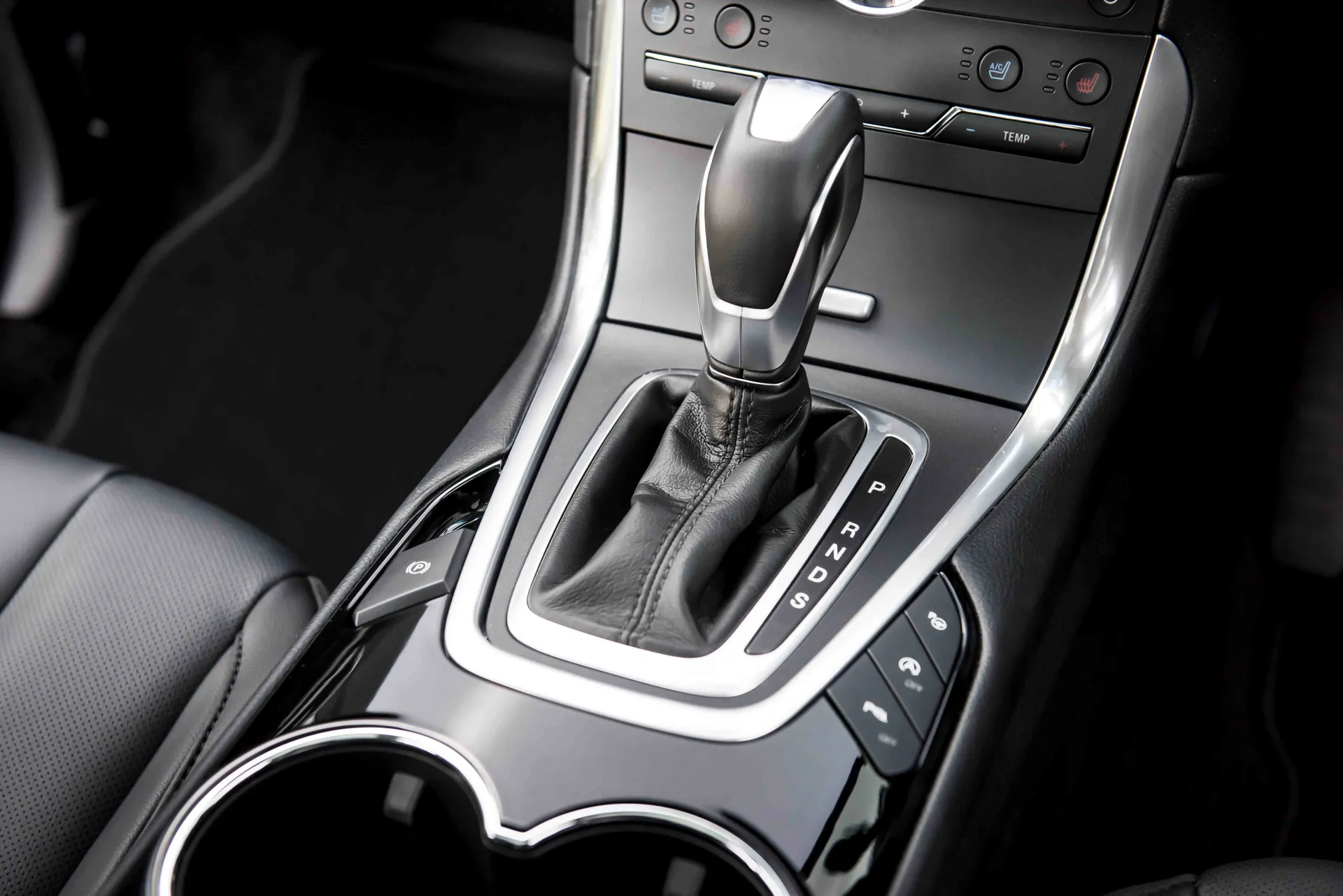
Even the front-drive model was only capable of an official 42.4mpg riding on its standard 19-inch alloy wheels. Our Real MPG testers never got close to that figure in the real world; in fact their average was only 31.1mpg.
The 238PS four-wheel drive car only fared slightly worse at 30.3mpg, according to owners, so at least there was no penalty for buying the quicker one. Still, some mainstream rivals got nearly 50mpg, and the Toyota RAV4 hybrid had much lower CO2 emissions, despite having less power and more straight-line performance.
Despite not being the most efficient large SUV, the Ford Edge had a massive US-style fuel tank. It's 66-litre capacity meant a cruising range of over 500 miles.
Ford Edge reliability and warranty
The Ford Edge scored a highly impressive 10 out of 10 for reliability in the HonestJohn.co.uk Satisfaction Survey, but before you got rushing out in search of one, it's important to bear in mind that the Edge was not a popular car in the UK, and so the sample size is very small indeed.
A recall was issued due to a problem with headlights deactivating, so be sure that any car you look at has had repair work completed.
Ford finished 26th out of 33 manufacturers in the latest Satisfaction Index, although conversely this may be affected by the popularity of Ford models in general. Whichever way you look at it, it's fair to say that the Edge probably wasn't the most reliable offering in the class.
Ford Edge insurance groups and costs
How reasonable you think the big Ford Edge's insurance costs are will largely depend on the other SUVs on your shopping list. The 238PS four-wheel drive ST-Line sits in Group 34. It's a few groups below where you'll find a similarly powerful Mercedes GLC or Audi Q5 3.0 TDI, but two higher than a Jaguar F-Pace R-Sport.
Unfortunately, it's also six groups higher than a Skoda Kodiaq vRS, which matched the output of the Ford but with better performance. It was worse if you go for the front-wheel drive 150PS Titanium, which is in Group 26.
Mainstream rivals like the Mazda CX-5, Kia Sorento, and Peugeot 5008 will all cost hundreds of pounds less.
VED car tax: What is the annual road tax on a Ford Edge?
You won't save heaps on tax, especially with the recent April 2025 changes, but it won't break the bank either. The 180PS 2.0 TDCi emits 149g/km, meaning cars registered before 1 April 2017 will cost £210 per year.
Opt for the 238PS (post-2017), and you'll pay the latest £195 standard rate.
Ford Edge price
"Weak residual values make the Ford Edge an excellent second-hand buy. You can pick up a 2016 180PS Sport for around £12,000, with 70,000 miles on the clock."
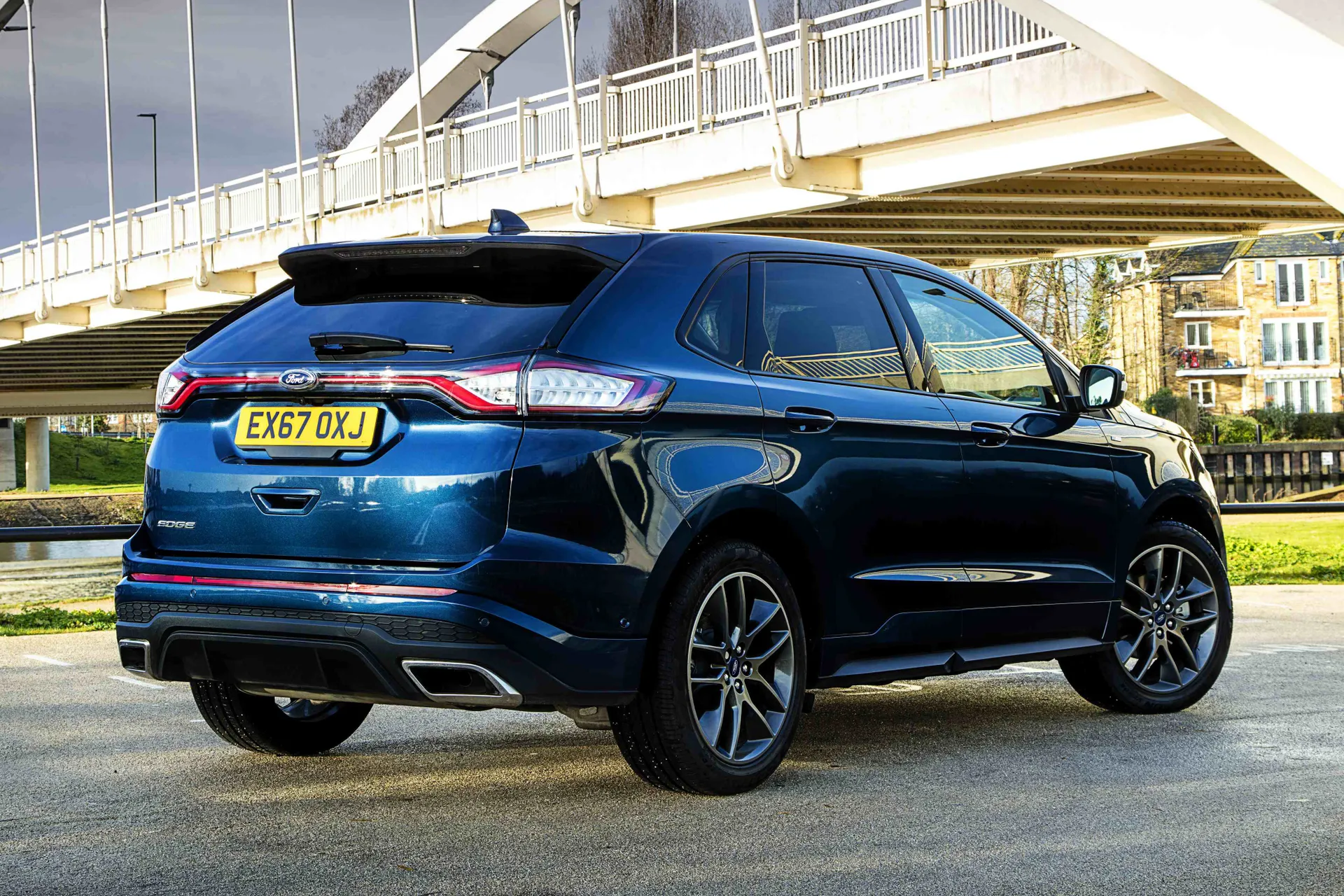
There are many mega-mileage cars around, dropping entry prices to £6,500. If you have a bit more to spend, low-mile Vignale and ST-Line trims demand upwards of £20,000.
Trim levels and standard equipment
There was no 'base' model as such, but before its 2018 facelift, the range entry point was a Zetec trim that skimped on a few toys to make it more affordable but still felt generously equipped. In the newer-shape Ford Edge, there were three main specifications: Titanium, ST-Line and the poshest Vignale. All had a specification list that would turn Audi, Mercedes and BMW buyers green with envy - it was that comprehensive.
Ford Edge Titanium cars had LED headlights, 19-inch alloys, power folding door mirrors, chrome detailing and dark privacy glass on the outside. Inside, it was a total gadget-fest, with electric leather front seats that can be heated or cooled, a nine-speaker stereo, sat-nav, climate control, digital instruments and radar-guided cruise.
Ford Edge ST-Line models had larger wheels and lowered sports suspension, and cosmetic exterior and interior upgrades to make it look even beefier. The only meaningful extras over and above the Ford Edge Titanium trim were the heated steering wheel, a booming 1,000-watt premium sound system from Bang & Olufsen, and in-car WiFi.
Flagship Ford Edge Vignale models were supposed to feel opulent and luxurious, with posh badges on the exterior, extra leather covering on some of the dash surfaces and fancier seats with more padding, but they weren't good value at all.
This overabundance meant the options list was short and sweet. The only two items worth mentioning are the glass sun roof (which we'd avoid since it eats into rear headroom) and a Driver Assistance Pack that could be added to the ST-Line and Vignale to make the Edge's exhaustive suite of active safety systems complete.
Ask the heycar experts: common questions
Which is bigger a Ford Edge or the Escape?
Does the Ford Edge come with the option of seven seats?
Is the Ford Edge a good used car?
Will Ford stop making the Ford Edge?
Can I buy a hybrid Ford Edge?
Ford Edge Alternatives
Get our latest advice, news and offers
Keep me updated by email with the latest advice, news and offers from heycar.
By submitting you agree to our privacy policy
